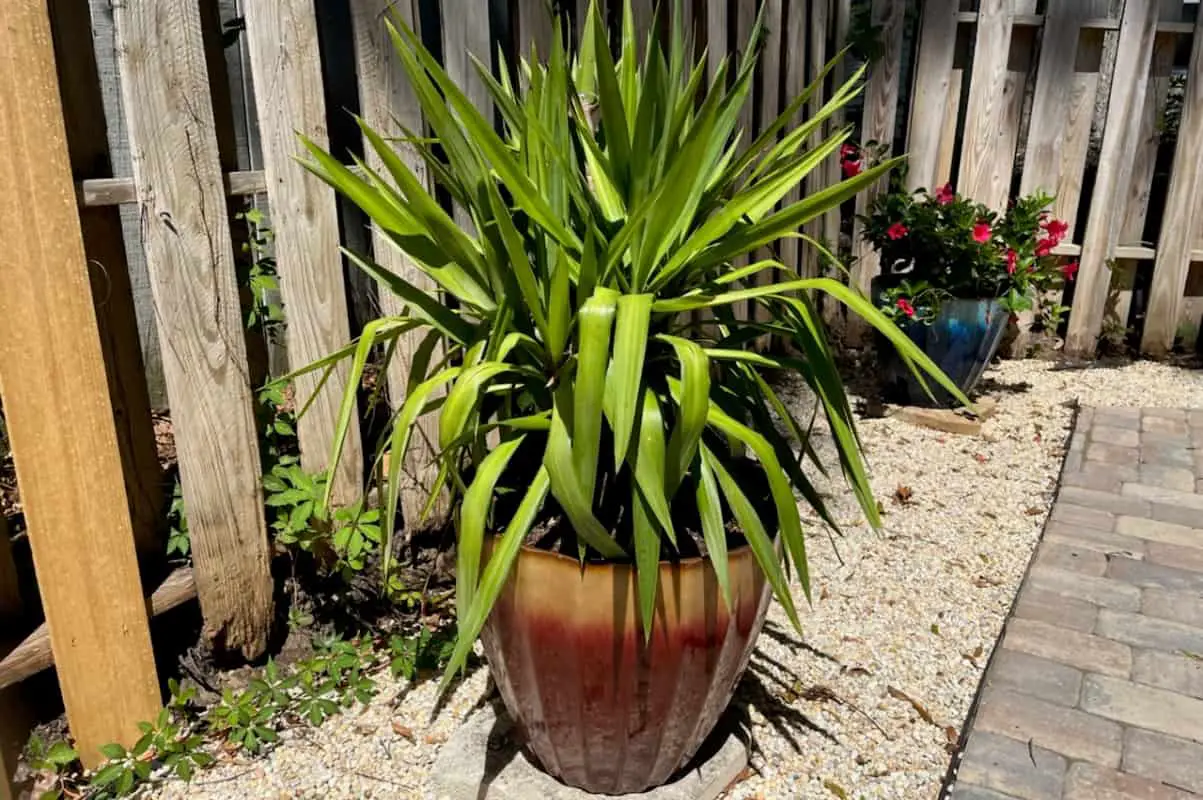Yuca Elephantipes Regal, also known as the Spineless yucca or the Giant Yucca, is a popular yucca for the home and garden. It adds an exotic look to a garden or pool deck. Inside, it also gives you a large plant that’s easy to maintain.
Spineless Yucca Large Plant
There’s a reason the Spineless Yucca is called the Giant Yucca; it grows tall. When mature outside, it can grow up to 30 feet. And the base becomes large as the Spineless yucca ages.
Even in a pot, the Spineless yucca can grow very tall.
Leaves and Flowers
The Spineless yucca leaves are relatively large. They can be two to three inches wide. A lot of mature Spineless yuccas leaves are up to four feet long. But don’t worry, these 30 feet tall yuccas are not the yuccas you place in your living room.
The leaf is smooth and doesn’t have a terminal spine; thus, the name Spineless. Unlike many yuccas that have stiff leaves, the Spineless has pliable leaves.
Spineless yucca leaves narrow at the trunk, widen in the middle and then narrow again at the end into a point. They also have a weeping appearance since the older leaves hang down.
The Spineless yucca can flower. Unlike other yuccas, the Elephantipes usually have a short flower stalk within the leaves’ head. It has small creamy white flowers that are densely arranged. Unfortunately, it’s rare for a potted Spineless yucca to flower.
Hey, you’ll like this one too: Do Yuccas Die After Flowering
Caring for a Spineless Yucca
A Spineless yucca is easy to care for. The key is not to overwater it. If you’re a heavy-handed waterer, you may not want this plant. It’s drought-tolerant, so if it’s outside, give it a hardy drink every three weeks, depending on rain and air movement. Inside, they may also need water every one to two weeks. Check before you water. The soil should be completely dry, not moist.
A Spineless yucca needs dry, well-draining soil. If you’re potting the yucca, avoid rich potting soil. Instead, mix perlite or vermiculite into the soil. This will give the yucca drainage and promote healthy roots. Always use a pot with a drainage hole.
If you are growing in the ground, choose an area that dries out. Avoid soggy areas or clay soil. If you’re forced to plant in clay, make sure your Spineless yucca is on a knoll or raised area to promote drainage.
It can be grown in bright sun or partial shade. Be careful about too much sun because the leaves may burn. The Spineless yucca can handle humidity.
Regions Spineless Yucca are Found
Elephantipes originated in the tropical areas of the Mexican Veracruz coast down to Guatemala. And it is found in tropical areas worldwide. Unlike other yuccas, the Spineless yucca is not indigenous to North America. Since the late 19th century, it has grown along the Mediterranean coast.
If grown outdoors in the U.S., it is found in central and southern Florida. It is also found in southern California. This is because it requires a frost-free environment. The Spineless yucca doesn’t tolerate the cold and can only tolerate temperatures down to 27 degrees Fahrenheit.
Of course, if you pot a yucca, it does well in your home. If you have your Spineless yucca potted outside, protect it from frost. Bring it in or cover it with a cloth sheet. You never want to use plastic.
Propagation Simple with a Spineless Yucca
Spineless yucca usually reproduce through pups at the plant’s bottom. This is because a Spineless yucca has rhizome roots. That means they spread horizontally. So you can cut the pup away from the plant, taking some of the roots with it.
You also may cut a branch from the main stalk. But be sure to plant the cutting in a pot, not in the ground, so that it can develop roots.
Hey, you’ll like this one too: What is Growing Out of My Yucca
Spineless Yucca Ornamental
The Spineless yucca can create a dramatic display in a home, yard or patio. It has a natural exotic beauty and looks almost tropical.
The Spineless yucca is often used as an indoor potted plant since it will tolerate some low light. It can be found in nurseries or many of the big box stores. The small ones are relatively inexpensive but the larger ones can cost over a hundred dollars.
Hey, you’ll like this one too: Are Yuccas Expensive
Conclusion
The Spineless yucca can be a great focal point in a garden or courtyard. It is natural on a pool deck to create that tropical look.
Because it’s easy to care for, it’s an easy, dramatic plant to add to a house or garden.

